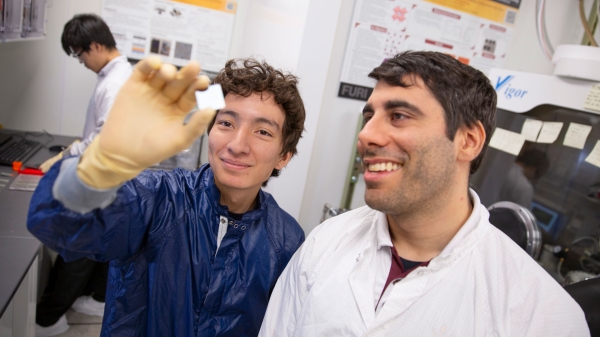Enthusiasm for weather and aviation launches career

Kenneth Brown, December 2016 Dean's Medalist for the School of Geographical Sciences & Urban Planning, has pursued two passions -- meteorology and aerospace engineering -- and is on his way to a career that integrates the two.
Editor’s note: This is part of a series of profiles for fall 2016 commencement. See more graduates here.
Kenneth Brown was always interested in weather, and by high school, had identified meteorology as his chosen area of study. A conversation about the role of meteorology in aviation added aerospace engineering to his educational plans.
The two fields have complemented each other numerous times as he’s worked towards the two degrees at Arizona State University. Last spring, when Ronald Calhoun, professor and instructor of Brown’s Renewable Energy Engineering course, asked students to work in groups to develop projects in that realm, Brown proposed looking at whether El Niño — the warm Pacific water that impacts weather across the U.S. — tends to reduce the amount of sunlight available for solar power generation in Phoenix.
A simple regression showed that there was, in fact, a statistically-significant relationship between El Niño conditions and reduced sunlight.
“My professor suggested I develop this into a paper to be submitted to a research journal,” Browns said.
Reviewers suggested expanding the project, and Brown set to work gathering solar and climate data throughout the Southwestern United States, and will use mapping software to analyze the connection throughout the region.
As he graduates from ASU, he’s already started on the next phase; a position with an Arizona-based aerospace firm that launches rockets into space.
“My job title is Guidance Navigation and Control Engineer, but I work in the aerodynamics group,” Brown said.
“A goal with rocket launches is to reduce the uncertainty of the path that the rocket will take. Atmospheric conditions are a large area of uncertainty, so being able to model atmospheric conditions will be really helpful in the work I’ll be doing.”
Question: What was your “aha” moment, when you realized you wanted to study aerospace engineering and meteorology? Did one happen before the other?
Answer: I was always passionate about meteorology. Then when I was in high school, a cousin of mine who works for an airline, doing flight routing, showed me a flight tracker display, that showed airplane tracks and also meteorological conditions. I realized that by doing majors in both meteorology and aerospace engineering, I could become involved in both these areas.
Q: Why did you choose ASU?
A: First, I wanted to be far enough from home, but not too far! Then, looking at different options, I realized the sheer amount of programs available at ASU. At ASU I’d be able to study both meteorology and aeronautics, as well as be able to explore all kinds of other areas. As a freshman I took a psychology course — it didn’t change my idea of what I wanted to major in, but it was great to have that opportunity.
Q: What’s something you learned while at ASU — in the classroom or otherwise — that surprised you, that changed your perspective?
A: In working on tornadoes, Dr. Cerveny, who leads the meteorology program within the geography degree, made the point that if, as a forecaster, you don’t do your job correctly, you could put people in danger. This drove home that I’d chosen an area of work that has a really significant impact on safety — human lives are at stake.
Q: What’s the best piece of advice you’d give to those still in school?
A: Find something you can be passionate about. It gives you the drive to work hard, and makes studying more fun.
Q: What was your favorite spot on campus, whether for studying, meeting friends or just thinking about life?
A: Old Main Lawn, especially in the summer. Evaporative cooling keeps it cool!
Q: If someone gave you $40 million to solve one problem on our planet, what would you tackle?
A: I would put the funding toward research in re-usable launch systems. This would reduce the cost to launch meteorological satellites, and could increase our ability to forecast dangerous weather conditions.
More Science and technology

ASU researcher part of team discovering ways to fight drug-resistant bacteria
A new study published in the Science Advances journal featuring Arizona State University researchers has found…

ASU student researchers get early, hands-on experience in engineering research
Using computer science to aid endangered species reintroduction, enhance software engineering education and improve semiconductor…

ASU professor honored with prestigious award for being a cybersecurity trailblazer
At first, he thought it was a drill.On Sept. 11, 2001, Gail-Joon Ahn sat in a conference room in Fort Meade, Maryland.…